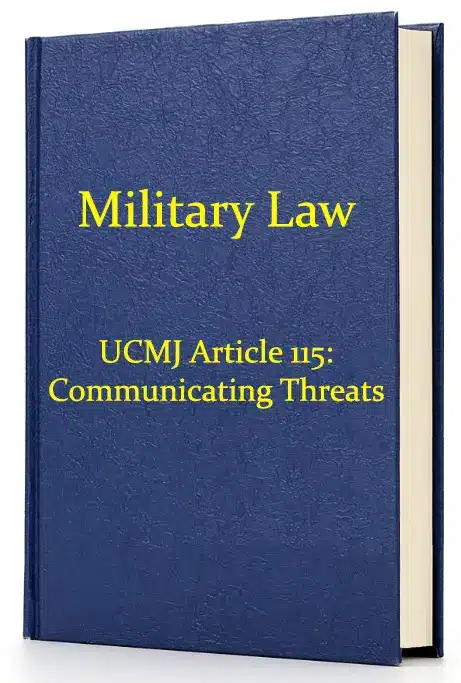The Manual for Courts-Martial states under Article 115 (Communicating Threats) that any service member may be prosecuted if they:
-
wrongfully communicates a general threat to injure the person, property, or reputation of another;
-
wrongfully communicates a threat to injure the person or property of another by use of an explosive, a weapon of mass destruction, a biological or chemical agent, substance, or weapon, or a hazardous material; or
-
maliciously communicates a false threat concerning injury to the person or property of another by use of an explosive, a weapon of mass destruction, a biological or chemical agent, substance, or weapon, or a hazardous material.
To be convicted for a general threat, the prosecution must prove:
-
that the accused communicated specific language expressing a present determination or intent to injure the person, property, or reputation of another person, presently or in the future;
-
that the communication was made known to that person or a third person; and
-
that the communication was wrongful.
The accused may be convicted of a threat to use explosives if they:
-
communicated specific language;
-
that the information communicated amounted to a threat;
-
that the harm threatened was to be done using an explosive; weapon of mass destruction; biological or chemical agent, substance, or weapon; or hazardous material; and
-
that the communication was wrongful.
Successful prosecution for false threats concerning the use of explosives, etc., requires the trial to demonstrate the following:
-
that the accused communicated or conveyed certain information;
-
that the information communicated or conveyed concerned an attempt being made or to be made using an explosive; weapon of mass destruction; biological or chemical agent, substance, or weapon; or hazardous material to unlawfully kill, injure, or intimidate a person or to damage or destroy specific property unlawfully;
-
that the information communicated or conveyed by the accused was false and that the charged then knew it to be wrong; and
-
that the communication of the information by the accused was malicious.
Understanding Article 115 (Communicating Threats) of the UCMJ
The term threat refers to an expressed and present determination or intent to kill, injure, or intimidate a person or to damage/destroy a specific property presently or in the future. The communication must be one that a reasonable person would understand as expressing a present determination or intent to wrongfully injure another person’s person, property, or reputation, presently or in the future. Proof that the accused intended to kill, maim, intimidate, damage, or destroy is not required.
A communication must be wrongful to constitute an Article 115 violation. The wrongfulness of the communication relates to the accused’s subjective intent. The accused must have communicated to issue a threat or with the knowledge that the communication would be viewed as a threat. If it is determined the communication was made in jest or was legitimate or innocent in its purpose, then the communication is not deemed wrongful.
Explosive refers to any substance used for blasting, detonators, detonating agents, smokeless powders, and any other explosive compound, mixture, or material.
Weapon of mass destruction refers to any device, explosive or otherwise, that is intended, or has the capability, to cause death or serious bodily injury to a significant number of people through the release, dissemination, or impact of toxic or poisonous chemicals, or their precursors; a disease organism; or radiation or radioactivity.
A biological agent is any microorganism, pathogen, or infectious substance and any naturally occurring, bioengineered, or synthesized component of any such substance that is capable of causing:
-
death, disease, or other biological malfunction in a human, an animal, a plant, or another living organism;
-
deterioration of food, water, equipment, supplies, or materials of any kind; or
-
deleterious alteration of the environment.
A chemical agent, substance, or weapon refers to a toxic chemical and its precursors, a munition, or a device specifically designed to cause death or other harm through toxic properties of those chemicals that would be released as a result of the use of such munition or device, and any equipment specifically designed for use directly in connection with the use of such munitions or devices.
A hazardous material is any substance or material (including explosive, radioactive material, etiologic agent, flammable or combustible liquid or solid, poison, oxidizing or corrosive material, and compressed gas, or mixture thereof) or a group or class of material designated as hazardous by the Secretary of Transportation.
A communication is deemed malicious if the accused believes that the information would probably interfere with the peaceful use of the building, vehicle, aircraft, or other property concerned or would cause fear or concern to one or more persons.
Maximum Possible Punishment for Violations of Article 115
Service members convicted of an Article 115 violation of communicating threats or false threats face a maximum possible punishment of a dishonorable discharge, forfeiture of all pay and allowances, and confinement for three years.
Suppose the accused is convicted of an Article 115 violation of threats or false threats concerning the use of explosives, etc. In that case, they face the maximum possible punishment of a dishonorable discharge, forfeiture of all pay and allowances, and confinement for ten years.
How do you defend against Article 115 Communicating Threats charges?
When facing the combined resources of the military and the current cultural climate, you need to be prepared to defend your career and your freedom. Crisp and Associates, LLC has a team of experienced trial attorneys with over 75 years of combined experience who have won these cases. This team includes the firm’s founder, Jonathan Crisp, a highly respected and sought-after attorney, speaker, and lecturer who has served in the U.S. Army Judge Advocate General’s Corps (JAG) since 1998 and entered private practice in 2007.
If you, or someone you know, is facing Article 115 charges for Communicating Threats, you need to speak with a Military defense attorney immediately. We understand what is at risk and learn how to protect your career, freedom, and future.


